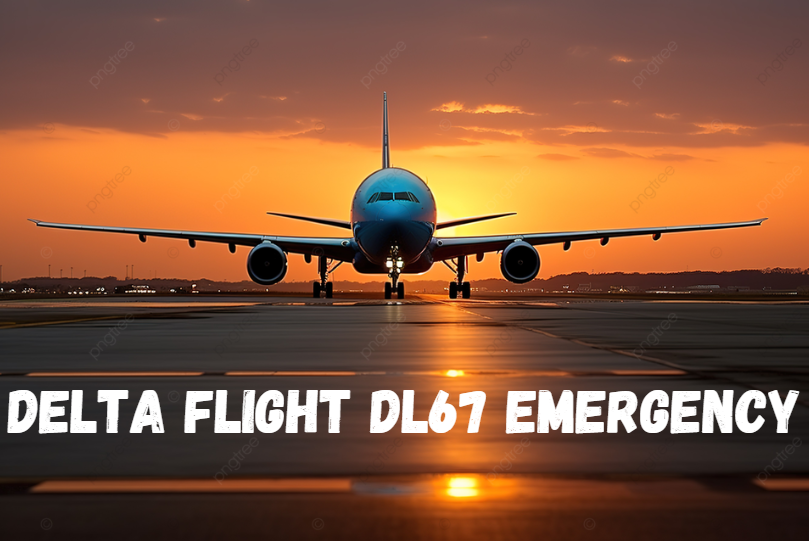Delta Flight DL67 Emergency is a topic that has garnered significant attention, particularly after the incident on April 11, when an Atlanta-bound Delta Airlines flight from Rome, Italy, had to make an unexpected diversion due to a medical emergency.
This article delves deep into the incident, offering not only a summary of events but also detailed analyses, insights, and interpretations that aim to provide a comprehensive understanding for readers in the USA. This analysis will cover the flight’s journey, the emergency response, potential causes, and the broader implications for aviation safety.
Contents
The Flight Overview: Delta Flight DL67
The Route and Scheduled Journey
Delta Flight DL67 is a regularly scheduled transatlantic flight operated by Delta Airlines, one of the largest airlines in the world. The flight originates from Leonardo da Vinci-Fiumicino Airport in Rome, Italy, and is destined for Hartsfield-Jackson Atlanta International Airport in Atlanta, Georgia. The flight typically covers a distance of approximately 5,000 miles and takes around 10 hours, flying over several European countries and the Atlantic Ocean.
The Incident: April 11, 2024
On April 11, 2024, Delta Flight DL67 was cruising at 33,000 feet over western France when the crew declared a general emergency. According to reports, the emergency was related to a medical situation involving one of the passengers. The crew acted swiftly, diverting the aircraft to Charles de Gaulle Airport in Paris, France, where it made an unscheduled landing.
The Medical Emergency
The specifics of the medical emergency were not disclosed immediately, but it was severe enough to prompt the flight crew to take decisive action. The passenger’s condition required urgent medical attention, which could not be adequately provided on board the aircraft. This situation highlights the critical role that flight crews play in ensuring passenger safety and well-being, particularly during long-haul flights.
Emergency Response and Protocols
Crew Training and Preparedness
Delta Airlines, like all major carriers, requires its flight crews to undergo rigorous training in emergency protocols. This training includes dealing with medical emergencies, where time is of the essence, and every decision can be crucial. The decision to declare an emergency and divert the flight to the nearest suitable airport reflects the crew’s adherence to these protocols and their commitment to passenger safety.
Communication and Coordination
Once the emergency was declared, the flight crew would have communicated with air traffic control (ATC) and Delta’s operations center. This communication is vital for coordinating the diversion, securing medical assistance on the ground, and ensuring that the aircraft has a clear and safe path to land at the nearest airport. In this case, Charles de Gaulle Airport, one of the largest and most well-equipped airports in Europe, was chosen for the emergency landing.
The Role of Air Traffic Control
Air traffic controllers play a critical role in managing in-flight emergencies. In the case of Delta Flight DL67, ATC would have prioritized the aircraft, providing it with a direct and expedited route to Charles de Gaulle Airport. The controllers also coordinate with ground services to ensure that emergency medical teams are ready upon the aircraft’s arrival.
Medical Assistance on the Ground
Upon landing at Charles de Gaulle Airport, the passenger in need of medical attention was likely transferred to a local hospital. In such situations, time is critical, and airports like Charles de Gaulle are equipped with medical facilities and personnel capable of handling emergencies.
The seamless coordination between the flight crew, ATC, and ground services is a testament to the effectiveness of emergency protocols in the aviation industry.
Potential Causes and Implications
In-Flight Medical Emergencies: Common Causes
In-flight medical emergencies are not uncommon, especially on long-haul flights where passengers may be seated for extended periods. Common causes of in-flight medical emergencies include cardiovascular events, respiratory issues, allergic reactions, and complications from pre-existing conditions.
While airlines are equipped with basic medical supplies, they are not substitutes for full medical care, making emergency landings necessary in severe cases.
The Decision to Divert: A Complex Judgment
The decision to divert a flight is complex and involves weighing several factors. These include the severity of the medical emergency, the availability of medical facilities at the diversion airport, the remaining flight time to the destination, and the impact on other passengers and flight operations. In the case of Delta Flight DL67, the crew’s decision to divert to Charles de Gaulle Airport reflects a careful consideration of these factors.
Broader Implications for Aviation Safety
The incident involving Delta Flight DL67 highlights the importance of preparedness in the aviation industry. While in-flight medical emergencies cannot always be predicted, the industry’s response to such incidents can be continuously improved. This includes enhancing crew training, improving communication systems, and ensuring that aircraft are equipped with the necessary medical supplies.
The Aftermath: Passenger Experience and Airline Response
Impact on Passengers
For the passengers on Delta Flight DL67, the emergency diversion would have been an unexpected and potentially stressful experience. Passengers were likely concerned not only for the individual who required medical attention but also about the delay and its impact on their travel plans. Delta Airlines would have communicated with passengers, providing updates and arranging alternative flights if necessary.
Delta Airlines’ Response
In the aftermath of the emergency, Delta Airlines would have conducted a thorough review of the incident. This review would include assessing the crew’s response, the effectiveness of communication with ATC and ground services, and the overall handling of the situation. The airline would also likely communicate with the affected passenger and their family to provide support and assistance.
Repercussions and Future Precautions
Incidents like the Delta Flight DL67 emergency serve as learning opportunities for airlines and the broader aviation industry. Delta Airlines, known for its commitment to safety and customer service, would likely take steps to address any identified gaps in their emergency response protocols. This could involve additional crew training, updating emergency procedures, or enhancing communication systems.
Insights and Analysis: What This Incident Teaches Us
The Importance of Crew Training and Decision-Making
One of the key takeaways from the Delta Flight DL67 emergency is the critical role of crew training and decision-making. The ability of the flight crew to assess the situation, communicate effectively, and make quick decisions under pressure is essential in ensuring the safety and well-being of passengers. This incident underscores the importance of ongoing training and preparedness for all airline personnel.
The Role of Airports in Handling Emergencies
The choice of Charles de Gaulle Airport as the diversion point highlights the importance of having well-equipped airports capable of handling emergencies. Airports with advanced medical facilities, efficient ground services, and the ability to prioritize incoming emergency flights play a crucial role in managing such situations. This incident serves as a reminder of the need for continuous investment in airport infrastructure and emergency preparedness.
The Psychological Impact on Passengers
While the focus of the Delta Flight DL67 emergency was understandably on the individual requiring medical attention, the incident also had a psychological impact on other passengers. The sudden declaration of an emergency and the subsequent diversion can cause anxiety and stress among passengers. Airlines can address this by providing clear communication, offering support, and ensuring that passengers are kept informed throughout the process.
The Future of In-Flight Medical Care
As air travel continues to grow, the aviation industry may need to explore new ways to address in-flight medical emergencies. This could include equipping aircraft with more advanced medical equipment, training crew members in basic medical procedures, or even exploring partnerships with telemedicine providers to offer remote consultations during flights. The goal would be to enhance the level of care available on board, reducing the need for emergency diversions in some cases.
FAQs
1. What caused the Delta Flight DL67 emergency?
The emergency on Delta Flight DL67 was caused by a medical situation involving one of the passengers. The specific details of the medical emergency have not been disclosed, but it was severe enough to require an emergency diversion to Charles de Gaulle Airport in Paris.
2. How often do in-flight medical emergencies occur?
In-flight medical emergencies are relatively rare but not uncommon, especially on long-haul flights. Common causes include cardiovascular events, respiratory issues, and allergic reactions. Airlines are equipped to handle many medical situations, but severe cases may require an emergency landing.
3. What happens during an in-flight emergency?
During an in-flight emergency, the flight crew will assess the situation, communicate with air traffic control, and take appropriate action. This may involve declaring an emergency, diverting the flight, and coordinating with ground services to ensure that the necessary medical assistance is available upon landing.
4. How does an airline respond after an emergency landing?
After an emergency landing, the airline will review the incident, assessing the crew’s response and the effectiveness of communication and coordination. The airline will also provide support to the affected passenger and their family and communicate with other passengers regarding any delays or changes to their travel plans.
5. Can airlines prevent in-flight medical emergencies?
While airlines cannot prevent all in-flight medical emergencies, they can take steps to minimize risks. This includes providing crew training, equipping aircraft with medical supplies, and ensuring that passengers with known medical conditions have access to necessary care during the flight.
In summary, the Delta Flight DL67 emergency offers valuable insights into the complexities of managing in-flight emergencies. Through careful analysis and reflection, the aviation industry can continue to improve its preparedness and response, ensuring the safety and well-being of all passengers.
Conclusion: Reflecting on Delta Flight DL67 Emergency
The Delta Flight DL67 emergency on April 11, 2024, serves as a powerful reminder of the complexities and challenges involved in managing in-flight emergencies. From the swift actions of the flight crew to the coordination with air traffic control and ground services, every aspect of the response was crucial in ensuring a positive outcome.
This incident highlights the importance of preparedness, communication, and decision-making in the aviation industry. It also underscores the need for continuous improvement in handling emergencies, ensuring that all passengers are safe and well-cared for, even in unexpected situations.




